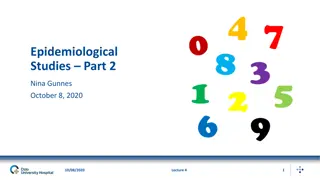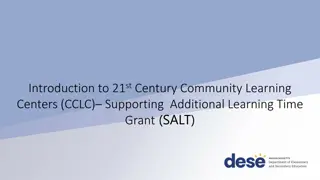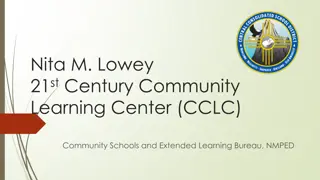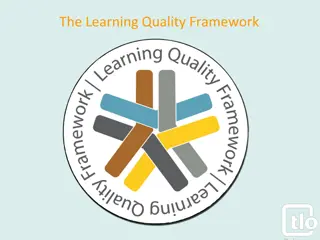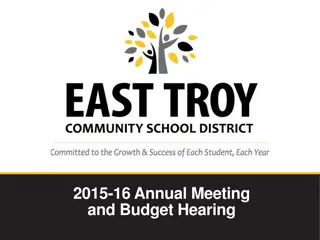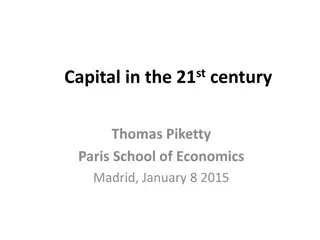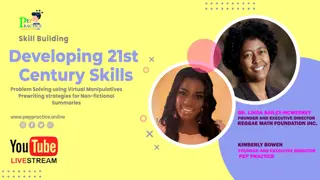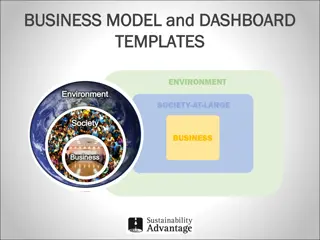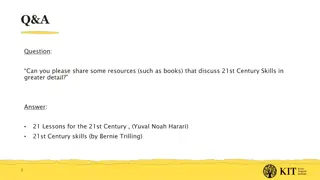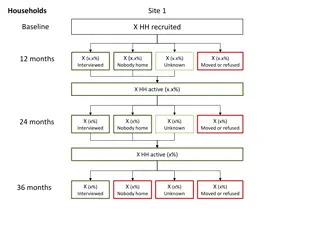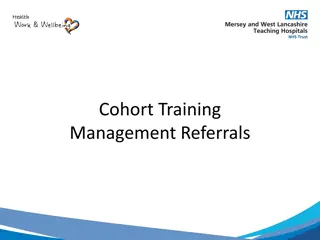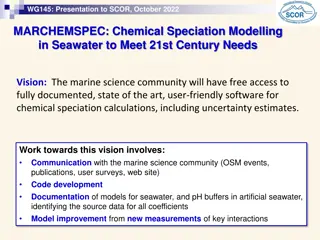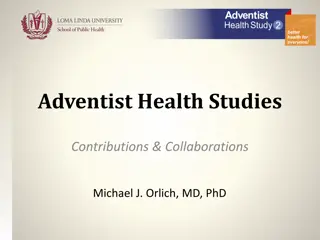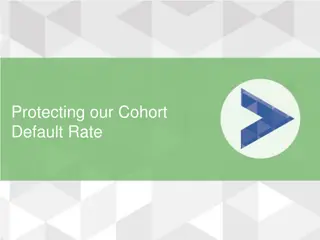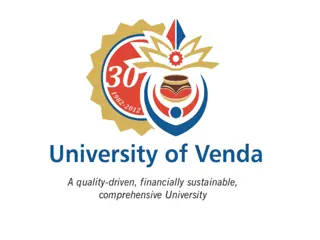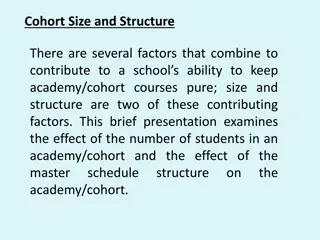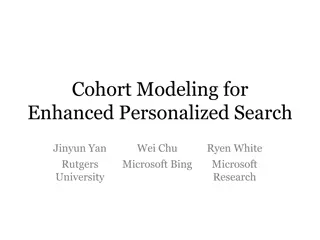21st Century Community Learning Centers Cohort 15 Overview
This document provides an overview of the 21st Century Community Learning Centers Cohort 15 Request for Applications by the California Department of Education's Expanded Learning Division. It includes information on objectives, background, purpose, components, eligibility, application process, and funding details for creating community learning centers for elementary, middle, and high school students. The program aims to provide a safe environment, academic enrichment opportunities, and support for college and career readiness.
Download Presentation

Please find below an Image/Link to download the presentation.
The content on the website is provided AS IS for your information and personal use only. It may not be sold, licensed, or shared on other websites without obtaining consent from the author.If you encounter any issues during the download, it is possible that the publisher has removed the file from their server.
You are allowed to download the files provided on this website for personal or commercial use, subject to the condition that they are used lawfully. All files are the property of their respective owners.
The content on the website is provided AS IS for your information and personal use only. It may not be sold, licensed, or shared on other websites without obtaining consent from the author.
E N D
Presentation Transcript
21stCentury Community Learning Centers Cohort 15 Request for Applications Overview California Department of Education Expanded Learning Division September 2023
Objectives Background and Purpose Components & Eligibility What s New? Application Process
21st Century Community Learning Centers Background: Federal Funding 5 year, non-renewable grants Authorized as the Every Student Succeeds Act (ESSA) Estimated $26 million allocated for 21st CCLC Elementary Middle School Programs Estimated $29 million allocated for 21st CCLC After School Safety and Enrichment for Teens
21st CCLC Purpose Create community learning centers for elementary and middle school students. Provide a safe environment for students participating in their programs. Provides access to enrichment services that reinforce and complement the academic program. Provide opportunity for family literacy and related educational development services. Helps students meet state and local academic standards. Provides opportunities to improve academic achievement.
21st CCLC After School Safety and Enrichment for Teens Purpose Provide local flexibility in the establishment or expansion of community learning centers for high school students Provide academic enrichment opportunities and activities designed to complement students regular academic program Support college and career readiness Assist with literacy and related educational development services for families
21st CCLC Program Components 21st CCLC Before School Programs After School Programs Summer/ Supplemental Programs Equitable Access *Grantees who currently have an after school base from a previous cohort may not apply for before school base, before school summer/ supplemental, after school summer/supplemental or equitable access in this RFA.
ASSETs Program Components ASSETs The ASSETs after school grants may operate after school, and during any combination of before school, weekends, summer, intercession, and vacation.
Eligibility (1) The application must target services to students who attend Title 1 schools with at least 40% FRPM that: are implementing comprehensive support and improvement activities, or targeted support and improvement activities under 20U.S.C. Section 6311(d), or other schools determined by the LEA to be in need of intervention and support (must also be Title 1) to improve student academic achievement and other outcomes, and serve the families of such students
Eligibility (2) An eligible entity refers to: LEAs, including school districts and county offices of education, and direct funded charter schools Private schools, provided that they serve public school students Nonprofit agencies Public entities, city and county government agencies, organizations, or other private entities Institutions of higher education Native American tribes or tribal organizations Community Based Organizations
Eligible Entities that may not apply for this RFA ASES programs looking to apply for before school or equitable access funding. 21st CCLC grantees are not eligible to apply for increased funding or additional components on current grants
Good Standing Current 21st CCLC, ASSETs and ASES grantees applying must meet FY 21-22 admin reporting requirements and have: o All attendance and expenditure reports completed per the EXLD and submitted prior to reporting deadlines. o All annual outcome-based data and APR data completed per the EXLD and submitted prior to reporting deadlines. o All annual audit and FPM findings resolved per the EXLD or in the process of being resolved per the CDE. If one or more sites is not in good standing by the specified due date, the grantee is ineligible and application will be disqualified per statute.
Whats New? (1) Charter Schools are not required to consult with private schools (refer to section J. Consultation with Private Schools). Assessments must be completed by every applicant and co-applicant(s) in which an application is submitted for the current 21st CCLC RFA Cohort 15. Completion of assessments prior to the RFA posting date will not be accepted as meeting the requirements of this current RFA. All components of the RFA are due by 4 p.m. on Thursday, November 16, 2023. Postmarks will be honored.
Whats New? (2) Grant reductions will be implemented for calendar year 2023 and will impact the priority and funding process for this current RFA (refer to section C. Grant Reduction). Narratives will be reviewed by readers holistically and receive an overall pass or fail score (instead of a score for each of the 12 sections.)
Whats New? (3) The appeals timeline is going from 30 days to 10 days. If a program wants to charge a fee, this must be approved by the U.S. Department of Education, not the CDE. Both applicants and co-applicants must be in good standing in order to be eligible to apply for 21st CCLC funding.
Application Process 1. The RFA submission, which is a two part requirement 2. Application Review and Evaluation 3. Geographic distribution 4. The funding priority 5. Free and Reduced Priced Meal determinations.
RFA Submission (Two-part Requirement) Part 1A 1A. Download and Submission into ASSIST Cover Page ESSA Assurances Authorized Designee Ed Code Assurances Signatures & Approvals Equitable Access Assurances Off-site Program Form Program Income Form and Narrative Private School Consultation Funding Priority Certification Co- Applicant Form Award Calculator Disqualification Form
RFA Submission (Two-part Requirement) Part 1B 1B. Upload of Application Narrative to FAAST Applicants must input their ASSIST-generated application identification number and application narratives into the separate online grant application system known as the FAAST.
Application Narratives The Quality Standards for Expanded Learning Programs in California (Quality Standards) provide the framework for the online application narratives for both 21st CCLC and ASSETs. Application narratives will be reviewed for quality based on the Quality Standards imbedded in the scoring rubrics. Information about the Quality Standards is available at: https://www.cde.ca.gov/ls/ex/qualstandcqi.asp
Scoring Passing Clear and complete Not Passing Not clear and not complete Developing quality Ambiguous quality Weak quality Feedback
Application Review and Evaluation Application Reviewers CDE reviews only for completeness and eligibility. Applicants who wish to appeal the email notification of the CDE screening disqualification or intent to award decision must submit a letter of appeal to the CDE within 30 days of the CDE s action. Appeals are limited to the grounds that the CDE s action(s) violate(s) a state or federal statute or regulation
Disqualifications (1) What gets an application disqualified? Not submitting the ASSIST generated forms to the CDE by the specified due date. Not uploading application narratives into FAAST by the specified due date. Failure for all applicants and co-applicants to complete the virtual trainings and pass each training with a score of no less than 80% by the specified due date. Identification on the federal debarment list at: www.dol.gov/ofccp/regs/compliance/preaward/debarlst.htm.
Disqualifications (2) What gets an application disqualified? Submitting an application without an original Authorized Signature or, if a Designee signature, without a copy of the governing board resolution or minutes authorizing the Designee to accept and sign as a proxy for financial statements and legally binding documents. A renewing or current grantee school that is not in Good Standing for FY 2023 24 at the time the application documents are submitted to the CDE and uploaded into FAAST by the specified due date.
Disqualifications (3) What gets an application disqualified? Virtual trainings and assessments: All applicants and co- applicants must complete a series of virtual trainings and assessments by the specified due date. If the trainings and assessments are not completed by the specified due date, applications will be disqualified.
Disqualifications (4) What gets an individual school site disqualified? Schools that are not Title I schoolwide A school without an active or pending CDS code or status as a charter school as verified by the CDE Charter School Division at the time the application is submitted in December. A school site that has a Free and Reduced Priced Meal percentage less than 40%
Geographic Funding Distribution (1) School sites in an application will be assigned to one of six geographic funding categories. The six geographic funding categories are as follows: 1. Northern-Urban 2. Northern-Rural 3. Central-Urban 4. Central-Rural 5. Southern-Urban 6. Southern-Rural
Geographic Funding Distribution (2) Sites can determine their Rural and Urban Classifications by visiting the National Center for Education Statistics (NCES) online tool: https://nces.ed.gov/ccd/schoolsearch/
Geographic Funding Distribution Northern Counties Regions 1-4 (1) Alameda Alpine Butte Colusa Contra Costa Del Norte El Dorado Glenn Humboldt Lake Lassen Marin Mendocino Modoc Napa Nevada Placer Plumas Sacramento San Francisco San Mateo Shasta Sierra Siskiyou
Geographic Funding Distribution Northern Counties Regions 1-4 (2) Solano Sonoma Sutter Tehama Trinity Yolo Yuba
Geographic Funding Distribution Central Counties Regions 5-8 Amador Calaveras Fresno Kern Kings Madera Mariposa Merced Monterey San Benito San Joaquin San Luis Obispo Santa Barbara Santa Clara Santa Cruz Stanislaus Tulare Tuolumne Ventura
Geographic Funding Distribution Southern Counties Regions 9-11 Imperial Inyo Los Angeles Mono Orange Riverside San Bernardino San Diego
Funding Priority Determined by individual school site Priority groupings where there are more sites than funding will be funded by FRPM % Equitable Access/ before school will only be considered if an after school base program has been funded through this RFA
What are the Priorities? A total of 5 possible priorities for 21st CCLC A total of 4 possible priorities for 21st CCLC ASSETs
21st CCLC & ASSETs (1) The application proposes to target services to students who primarily attend Title 1 schools, with an FRPM percentage no less than 40%, that: (1) are implementing comprehensive support and improvement activities, or targeted support and improvement activities under 20U.S.C. Section 6311(d), or (2) other schools determined by the LEA to be in need of intervention and support (also Title 1) to improve student academic achievement and other outcomes, and serve the families of such students.
21st CCLC & ASSETs (2) The application is jointly submitted by at least one Title I LEA and another eligible entity, or Demonstrates that the LEA or entity is unable to partner with a CBO in reasonable geographic proximity and of sufficient quality. Note: A justification narrative for why an applicant is unable to partner with an eligible entity may be considered by the CDE in order to receive priority consideration for this item. The justification narrative must be included in the application materials submitted to the CDE by the application deadline. The justification narrative does not apply to applicants that are able to partner with a eligible entity.
21st CCLC and ASSETs (3) The application proposes to target services to schools that enroll students who may be at risk for academic failure, dropping out of school, involvement in criminal or delinquent activities, or who lack strong positive role models, and serve families of such students.
21st CCLC Only (1) The applicant will provide year-round expanded learning programming at the school, including programs that complement existing ASES funded base programs or 21st CCLC base programs included in this RFA. Year-round expanded learning programs are defined as any combination of year-round programming or summer/supplemental programming including operation during summer, weekends, or intercession to complement existing ASES programs or a 21st CCLC after school base programs in this RFA. The applicant is not required to be the same entity that operates the existing program, but shall identify the grantee with whom the applicant is coordinating for the purpose of providing year- round programming.
21st CCLC Only (2) Replacing the school s expiring Cohort 12 21st CCLC grants if the program has satisfactorily met grant requirements.
ASSETs Only Programs that previously received funding for an ASSETs grant, that is not currently expiring, proposing an expansion to the existing grant (up to the per site maximum), or programs replacing expiring Cohort 12 grants that have satisfactorily met grant requirements.
Free and Reduced Priced Meal Determinations In determining grant awards, the CDE will consider each school site included in an application as if it were an independent application for that site alone Retrieved from the CALPADS FY 2022 23. An Applicant agency may therefore receive funding for all, some, or none of the school sites contained in the application.
Funding Determination 1. Application and Narrative Submission 2. CDE reviews for eligibility and completeness 3. Disqualification letters are disseminated 4. Program Narratives are read and passed or failed 5. Each site is placed in 1 of 6 geographic funding locations 6. Funding priority is determined for each sit 7. In the case of a tie, FRPM percentage is used 8. Intent to award is disseminated
Appeals (1) 1. Letter of Appeal: Applicants who wish to appeal the email notification of the CDE screening disqualification or intent to award decision must submit a letter of appeal to the CDE within 10 days of the CDE s action. Appeals are limited to the grounds that the CDE s action(s) violate(s) a state or federal statute or regulation.
Appeals (2) 2. Decision: If an applicant timely requests a hearing, it will be held within thirty (30) calendar days of receipt of the letter of appeal. At least 10 calendar days written notice of the time and place of the hearing will be given. The hearing will be on the record. 3. Hearing: The impartial panel shall issue a decision in writing, by 30 calendar days after the submission of the case.
Helpful Tools Use the Application Checklist located in the RFA Review the RFA FAQ s Review the general FAQ s located on the Expanded Learning webpage. Contact the EXLD RFA Help Desk Email: 21stCCLCandASSETSRFA@cde.ca.gov Contact the ASSIST Help Desk Email: ASSIST@cde.ca.gov Contact the FAAST Help Desk Phone: 866-434-1083 (M F 8:00 a.m. 5:00 p.m.) Email: FAAST_ADMIN@waterboards.ca.gov




